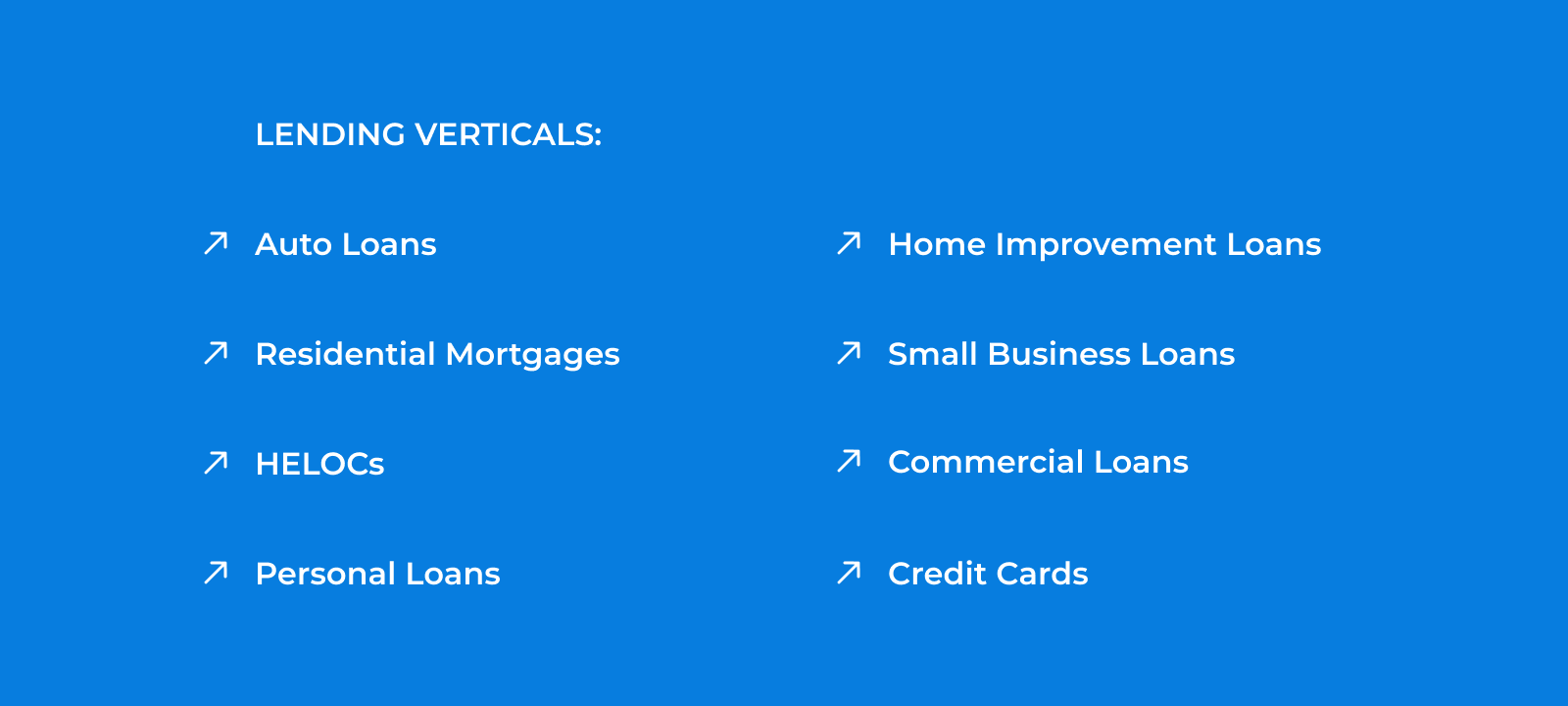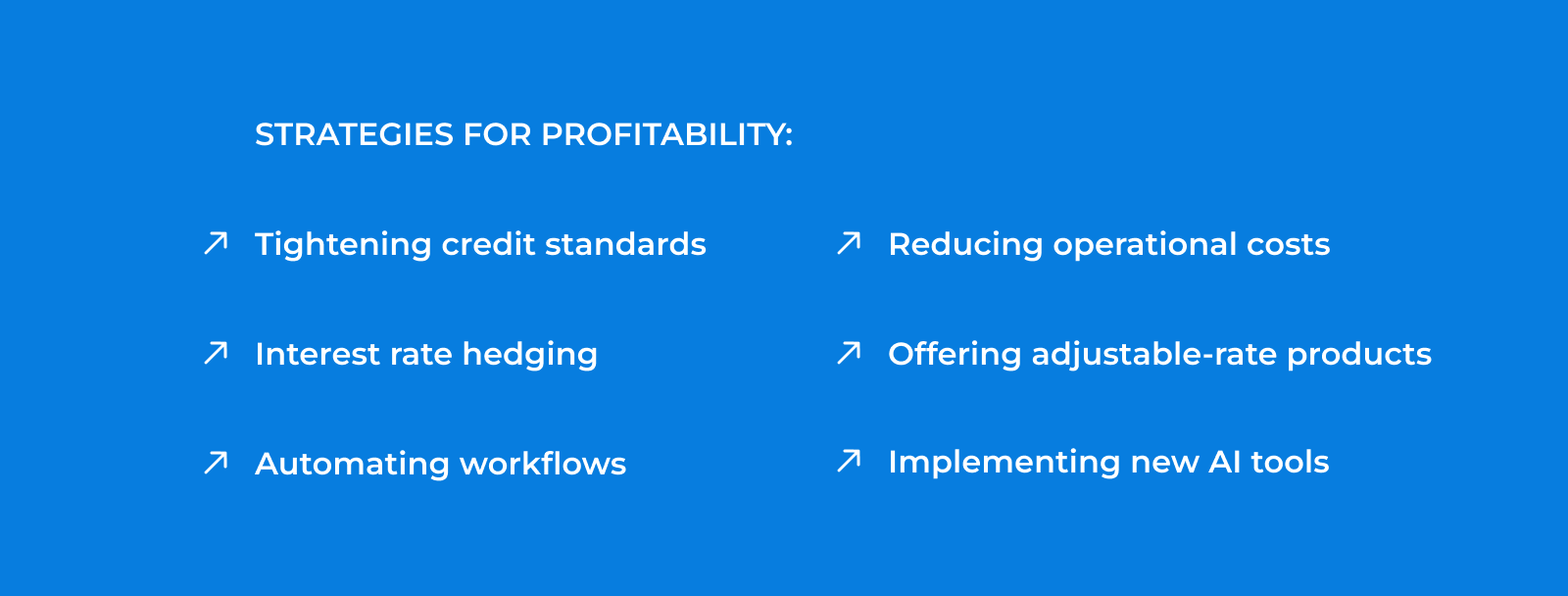Navigating the Impact of High Rates Across Lending Verticals - Strategies for Profitability

Introduction
The lending landscape is experiencing significant shifts in response to rapidly-increasing interest rates throughout 2022-2023. These changes affect various lending verticals differently and bring unique challenges for lenders, so understanding and adapting to these challenges is crucial for maintaining profitability in a complex environment.
In this blog post, we’ll delve into the impact of high interest rates on different lending verticals, including auto loans, credit cards, HELOCs, residential mortgages, personal loans, home improvement loans, small business loans and commercial loans. We will also discuss strategies for maintaining profitability across all categories, such as tightening credit standards, interest rate hedging, automating workflows, reducing operational costs, using adjustable-rate products, and implementing new AI tools to reduce costs.

Auto Loans
In a high-interest rate environment, potential car buyers face higher monthly payments than in prior years, which can reduce demand for new vehicles and slow down the auto lending market. Lenders may face heightened competition for a shrinking pool of qualified borrowers, leading to potential pressure on loan pricing and profitability. To cope with these challenges, lenders may consider offering more flexible loan terms, adjustable-rate products, or promotional incentives to attract borrowers who may be hesitant to take on loans with higher interest rates.
They might also need to focus on enhancing the borrower experience and offering value-added services, such as vehicle maintenance packages or fuel discounts, to differentiate themselves from competitors. At the same time, lenders may also need to adjust their underwriting criteria to account for the increased likelihood of defaults and repossessions as inflation shrinks borrowers’ overall ability to pay.
Residential Mortgages
In a high interest rate environment, residential mortgage lending can be significantly affected as borrowers face higher mortgage payments, leading to decreased affordability and potentially lower demand for home purchases. Furthermore, high-interest rates can lead to a slowdown in refinancing activities, as homeowners may be less likely to refinance their existing mortgages at higher rates.
To navigate these challenges, lenders may need to focus on offering adjustable-rate mortgages, which can be more attractive to borrowers in a high rate environment, and providing personalized loan options, such as interest-only or graduated payment mortgages, to cater to different borrower needs. They should also consider streamlining their loan origination processes to reduce costs and turnaround times, making their services more competitive.
HELOCs
High interest rates can negatively impact the Home Equity Line of Credit (HELOC) market by decreasing borrower demand for credit due to higher costs, and reducing the amount of equity they can tap into due to potential impacts on housing prices. This could result in reduced loan originations and a slowdown in the HELOC market. Lenders may need to adapt by offering competitive interest rates, flexible repayment options, or alternative loan products such as adjustable-rate home equity loans. They should also consider enhancing their digital presence and providing online tools to help borrowers easily access and manage their home equity lines of credit.
To the positive, we may find that HELOCs experience a resurgence due to a reduction in new home purchases. As less people purchase homes (due to higher mortgage costs), more may choose to renovate or improve their existing home by tapping into a HELOC.
Personal Loans
High interest rates can impact personal loan demand as borrowers become more cautious about taking on new debt, and the cost of borrowing increases. Lenders may face challenges in maintaining profitability due to reduced loan volumes and increased credit risk.
To address these challenges, lenders might consider tightening their underwriting standards, leveraging alternative data sources to better assess borrower creditworthiness, and focusing on.
Niche markets or specific loan purposes, such as debt consolidation or medical expenses, to differentiate themselves from competitors. They may also invest in digital lending platforms to streamline the loan application and approval process, reducing costs and improving borrower experience.
Home Improvement Loans
In a high interest rate environment, homeowners may be more hesitant to take on home improvement loans due to increased borrowing costs, leading to a potential slowdown in the home improvement loan market. Lenders may need to adapt by offering competitive loan terms, promoting energy-efficient home improvement options that can result in long-term savings for borrowers, or partnering with contractors to provide bundled financing and improvement packages. Developing targeted marketing strategies to reach homeowners who are most likely to undertake home improvement projects can also help lenders maintain profitability in this vertical.
Small Business Loans
Small businesses often face unique challenges in accessing financing during periods of high interest rates, as they may have limited credit history or lack collateral. High interest rates can exacerbate these challenges by increasing borrowing costs and reducing the overall availability of credit. Lenders may need to focus on offering flexible loan terms, working capital solutions, or SBA-backed loan programs to help small businesses access the financing they need.
Additionally, leveraging technology to streamline the loan origination process and utilizing alternative data sources to assess small business credit risk can help lenders maintain profitability while serving this crucial market segment.
Commercial Loans
High interest rates can impact the commercial lending market by increasing borrowing costs for businesses, potentially leading to reduced investment and expansion activities. Lenders may face challenges in maintaining loan volumes and managing credit risk in this environment.
To address these challenges, lenders could focus on offering tailored financing solutions, such as interest rate swaps or cap structures, to help businesses manage their interest rate exposure. Furthermore, lenders might consider enhancing their risk management practices, such as conducting more rigorous stress testing or requiring additional collateral, to mitigate potential credit losses.
Credit Cards
Credit card lenders tend to already have high interest rates - typically at or near usury limits (maximum federal or state rates). Therefore, the impact of higher government rates may be more muted on this vertical than others. That said, increased rates can discourage borrowers from carrying balances and prompt them to pay off existing debt more quickly, and lenders may face challenges in acquiring new customers as borrowers become more cautious about taking on additional debt.
To address these challenges, lenders may need to focus on promoting responsible credit usage, offering competitive rewards programs, and developing targeted marketing strategies to attract and retain customers. They could also explore innovative credit card products, such as low-interest or no-interest balance transfer cards, to help borrowers manage their debt more effectively.

Strategies for Profitability Across All Lending Verticals
To maintain profitability across all lending verticals in a high interest rate environment, lenders should consider implementing several general strategies, including:
- Tightening credit standards: Lenders may need to be more selective in extending credit to reduce potential defaults and maintain credit quality.
- Interest rate hedging: Utilizing interest rate derivatives, such as swaps or caps, can help lenders manage their interest rate risk and protect their net interest income.
- Automating workflows: Investing in technology to automate loan origination, underwriting, and servicing processes can reduce operational costs and improve efficiency.
- Reducing operational costs: Streamlining processes and optimizing resource allocation can help lenders maintain profitability despite reduced loan volumes and increased borrowing costs.
- Offering adjustable-rate products: Providing adjustable-rate loan options can make borrowing more attractive to some customers in a high interest rate environment because they know that their borrowing costs will decrease when rates go back down.
- Implementing new AI tools: Leveraging artificial intelligence and machine learning technologies can help lenders improve their risk management practices, enhance borrower experience, and streamline their operations.
How DigiFi Can Help
DigiFi offers next-generation technology solutions that automate the lending process, enabling lenders to efficiently manage different loan products in a single platform. By consolidating multiple systems into one comprehensive solution, lenders can reduce costs and streamline their operations. DigiFi's platform also provides digital borrower portals and automated underwriting tools, reducing the time and cost required to originate new business and enhancing the overall borrower experience. To learn more please visit www.digifi.io.
Conclusion
In conclusion, navigating the challenges posed by high interest rates requires a proactive approach from lenders. By understanding the unique impact of high rates on different lending verticals and implementing strategies to maintain profitability, lenders can continue to thrive in a complex and ever-changing market.
Partnering with technology providers like DigiFi can help lenders stay ahead of the curve and optimize their operations for success in any interest rate environment.
Published April 24, 2023

